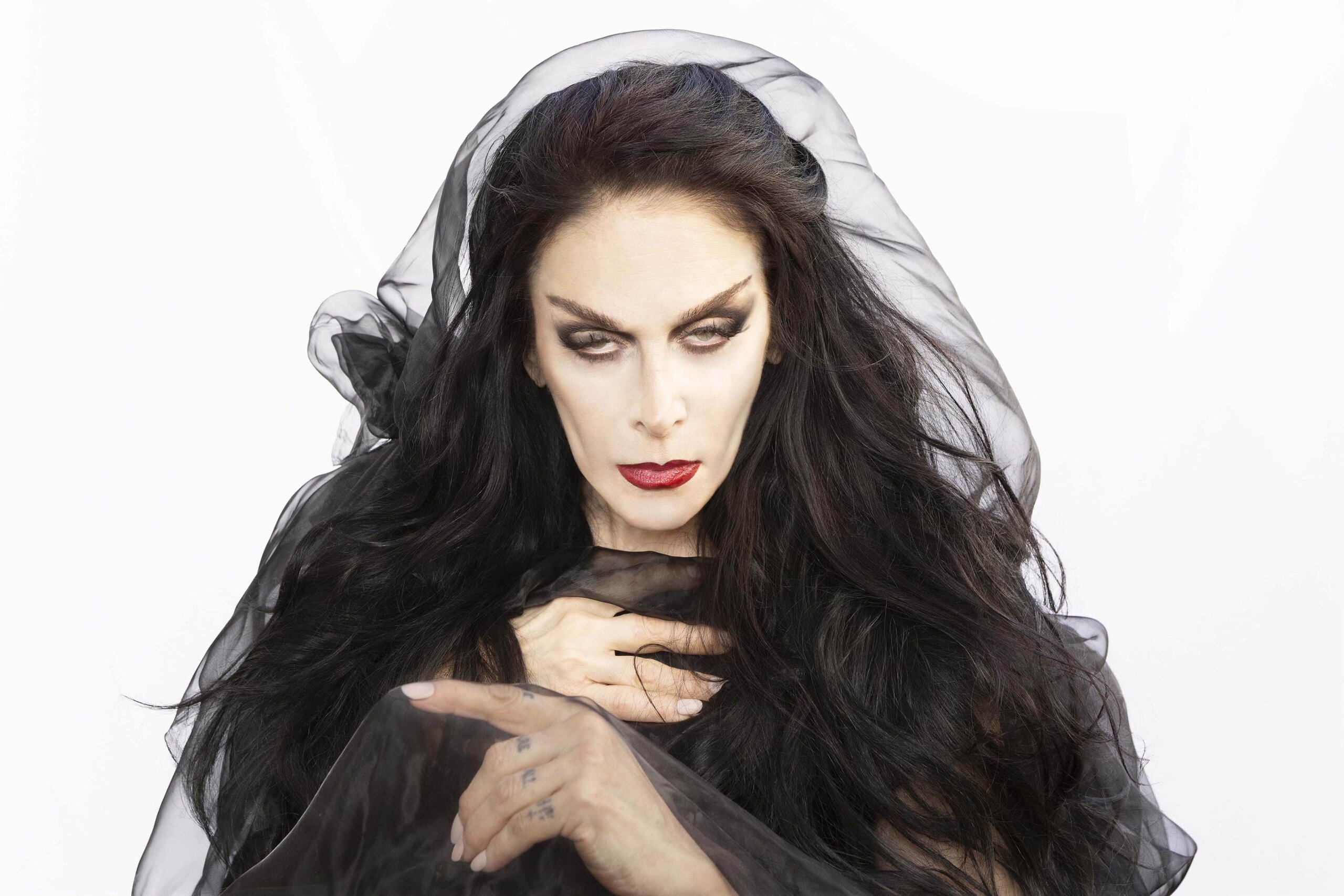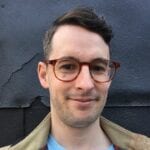Diamanda Galás is an intimidating interview subject, to say the very least. Since the release of her 1982 debut album, The Litanies of Satan, with its harrowing b-side “Wild Women with Steak-Knives (The Homicidal Love Song for Solo Scream),” the Greek avant-garde icon has given voice to the victims of history’s most nightmarish horrors. Throughout her pitch-black yet deeply compassionate body of work, Galás’s operatic techniques have allowed her to wail like a banshee, cast an ancient spell or growl like a demon from the seventh circle of hell.
In the late ’80s, while living in San Francisco, Galás released a trio of albums about the ravages of the AIDS epidemic. The Divine Punishment was the first entry in her Masque of the Red Death trilogy, personifying the pain and suffering of loved ones (including her brother) in its harrowing incantations of Old Testament scripture. A remastered reissue arrived this June. Listening back now, Galás views many parallels between the album’s original subjects and the medically compromised elders left to die during the COVID-19 pandemic. As she explains, lawmakers are still using interpretations of biblical verses to decide the fate of those deemed invalid to society, making the words recited on The Divine Punishment just as terrifying in 2022: “This is the law of the plague/ To teach when it is clean and when it is unclean.”
On her upcoming album, Broken Gargoyles, Galás travels back to a different moment in time to interrogate the atrocities of the First World War. The title refers to soldiers injured during battle, then further disfigured by military surgeons before being sent back to fight in metallic masks, which hid their monstrous faces. Against a backdrop of Galás’s echoing pianos and apocalyptic drones created by sound designer Daniel Neumann, her voice descends into ancient depths of horror. Once again pushing herself and the listener to the extreme, she sings from the perspective of both the mutilated and the mutilator.
“This is the law of the plague/ To teach when it is clean and when it is unclean.”
Thankfully, when I reached Galás on Zoom, our conversation was far less scary than her music. Sharing stories about the dangerous recording location of The Divine Punishment, and how moving back to her hometown of San Diego allowed her to complete Broken Gargoyles, she even revealed her less than favourable opinions about Lady Gaga. At age 66, Galás remains outspoken, eloquent and uncompromising.
I read an interview you did in 1994 where the first thing the writer said was, “Smack me if I mention anything you don’t want to talk about.” You can do the same thing to me today with a virtual smack.
[Laughs] I think that’s the perfect beginning of an interview!
Are you living in San Diego again these days?
Yes, I moved back to San Diego to stay with my mother when she became extremely ill. I’ve been here for a few years since her death. I come from a Greek family, so there’s a time of mourning, and I’ve observed that. This was the home I was raised in, so there’s a great amount of feeling that I have for the place. I wanted to hold on to that for a while.
How do you feel about the city? Does it suit your temperament?
Not at all. It’s the antithesis of my temperament, but I’ve done work here that I could never do in New York. It’s a kind of internal research that wouldn’t have been possible if I were out doing concerts. I had to devote myself exclusively to my new album. The project started in 2012, and I did a lot of work until 2014. Then when I moved here a few years ago, I started to work on it again, and now it’s done. I’m very, very proud of it because it’s a distillation of intense work.
Before you became a musician, why did you decide to study biochemistry and immunology?
I just felt an affinity for it. At age 17, I was offered the opportunity to work at the Scripps Research Institute in hematology. That was a really interesting job, even though I was only a lab technician, and far from being a scientist. Anybody who thinks that is tripping because the most intensive work I did was on myself. I got together with a bunch of dope fiend pre-med students and we conducted our own experiments.
When you first became involved with collective action and campaigning for AIDS education, did your science background play into that?
Yes, it certainly did. I believe that type of inquiry that one does in the sciences is very important because it’s fact-based, not feeling-based. If you want to understand the paradigm of the AIDS epidemic, you have to do research in many different areas. I’ve released four albums on that topic, but just have to laugh because 10 albums wouldn’t be enough.
There was one doctor who was well known in New York for denying that HIV existed. People going to him received virtually useless drugs, and he believed they didn’t need to know their viral load or the number of T-cells. Then you had the insanity of doctors, psychologists and pop stars saying that it could be eliminated through meditation or getting to know yourself better. People with HIV were very susceptible to it because of the derision of the press, which indicated only negative outcomes. That destroyed a lot of lives.
What do you remember about recording The Divine Punishment?
I recorded the first piece in a studio called the Decapitation Unit. It was in Hunters Point, which is a very dangerous place in San Francisco. That’s why a friend of mine was able to get a studio there. They had really interesting synthesizers that I was able to work with, and the album started there. In 1984, the person who was working as my manager told me that anyone in the art world who wanted to concentrate on the AIDS epidemic would not gain from it. He said I would lose my reputation and no one would want to book me. I looked at him and said, “Well, too bad!”
You’ve said that you don’t like to revisit your work, so what was it like to listen to the album again for this new edition?
Let me tell you, I considered it a sort of punishment. In order to have these works remastered, I had to listen to them again and give notes to the mastering engineer. It was punishing to listen back to because it’s a pretty extreme use of the voice, but the fact is that it’s absolutely important. If you’re going to remaster something, you have a chance to hone in on frequencies that were not heard back then because of less sophisticated machinery.
How did you choose the texts from the Old Testament that you read on the album? Were you familiar with the Bible before that?
I’m not a churchgoer. It’s not because there’s anything wrong with the Greek Orthodox church, for example, though I don’t follow any of their Biblical mandates. I like the ceremonial aspects, the music, the incense and, shall I say … the whole drag show. I’m just not really down with the rest of it.
Leviticus, which I used for the album, is a book of laws about separating the clean from the unclean. It separated people who were at that time believed to be victims of the plague because of sin from those who weren’t because of their purity. That’s been used in every epidemic. It’s up to the lawmakers to decide who are impure, and very clear where they stand when laws are put in place against anyone copulating with a member of their own sex.
Some other chapters that I read came from the Psalms of David. Those were about a person who had been buried alive, pleading to be rescued. Or a person who was being buried alive, pleading not to be cut off from society. We’ve seen this repeated during COVID-19 with old people in nursing homes who were considered unclean. People in their ’90s have virtually no immune system to fight the virus, so they were basically given their expiration dates.
That breaks my heart.
They were treated the same way soldiers were treated during World War I, to bring things back to Broken Gargoyles. The soldiers who were deemed capable of continuing to fight were taken to a hospital. Those lying on the road who were seen as too severely injured to be helped were just left there. It was horrific.
There were so many operations during the time period in which Ernst Friedrich put his book War Against War together. The patients who were severely deformed were forced to become patients in what was called Innovative Experimentation. They were people who could not fight against it because they were so sick and incapacitated by their injuries. By the time they did the last operation, the person was monstrous and would have to wear a metal mask that the hospital provided. Then they were sent back into battle! The understanding is that they would serve in the back lines, and the next time they would come in they’d be dead.
There were special houses hidden in different parts of the forest for those who had lost arms, legs, parts of their face or were blind. Only certain doctors and nurses would go there. I believe this continues now, but people will not discuss it. I’ve visited veterans’ homes and heard some shocking things. In my work, I’m discussing the attitude during and after World War I of hiding the people with mutilated faces and providing them with no sanctuary. If they couldn’t fight, they were kicked out of the hospital and left on their own. They had nowhere to go because they were living horrors.
I recently interviewed the musician Cormac Culkeen from the band Joyful Joyful, who cites you as a major inspiration. They say you sing like “15 people and a legion of demons.” How do you feel about descriptions like that?
I think it’s accurate. Not because I’m attempting to do that by any means, but because the voice is a medium, just like paint. Colours of paints can be seen as parallel to the timbres of the voice in which you use every coloration you can get to extract an emotion like sadness, or the agony of trying to escape from the grave. I describe the people who were put in those small houses in the forest as dead alive. They were sustained, but they were not alive.
It’s mandatory for anyone doing experimental work with a voice, which I do, to master the basic bel canto technique. Then you can continue using that as a rock on which to build, let’s say, integrative vocal techniques. You can go from singing in a soprano voice to suddenly doing a multiphonic passage. It’s really important to know your technique because otherwise you won’t be able to sustain yourself.
I definitely agree. You have to learn the rules before you can break them.
Thank you for saying that! This is one thing that I find really curious. A lot of people from the heavy metal world talk to me about the voice because they’re pushing their voice in a different way than a lot of other singers. I tell them you can’t be content singing in one style like [sings in a demonic voice]. That’s fascinating, but the truth is that it gets a bit dull after a while, doesn’t it?
Singers are often guilty of not having the same technical elegance as the other players in the band. If you’re a singer, you have to think about yourself as a musician. Not just as someone walking around with a naked torso and a few whips around your head or whatever. It’s all fascinating, visually, but if the voice doesn’t measure up to that, all is lost.
This is how I felt about Lady Gaga when she first arrived with these dazzling videos and music that seemed very dull by comparison.
Oh god. I’ve attempted to listen to her because people have told me she’s doing something interesting, but it’s torture for me! She’s taken visual elements from the art world, but used them in the wrong context. Those visual elements are part and parcel of an outlaw or rebel stance. They’re not designed to be implemented by or for ridiculous, lightweight, crap music that isn’t even worthy of a margarine ad.
In your recent New York Times interview, you mentioned performing within an installation created as part of Broken Gargoyles. Is that something you will do more?
Initially, I performed a 25-minute piece for voice, tape, piano and electronics at the Dark Mofo festival in Tasmania, and a few other festivals in Europe. Then I performed a larger piece called “The Operation,” which was more like an hour and 25 minutes.
At some point, I decided to create the work as an installation because I was invited to submit a video work with music to the Fridman Gallery in New York during COVID. I had never done anything like that kind of camera work, and it was an experimental process for me to do it at all like that. Doing the music was one thing, but doing a video as well was pretty challenging during the timeframe we had of six weeks. I enjoyed the experience a great deal.
I’ve only allowed the installation to be played in places like the Leper Sanctuary in Hanover, Germany, which was built around 1250 A.D. That’s an ancient place that was used to house lepers and victims of the plague. I also did it at a monastery in Braga, Portugal, just a couple of months ago. Those are the kinds of places where I want my music to be heard.
This interview has been edited for length and clarity.
Correction: July 20, 2022 1:10 pmHunters Point is in San Francisco. Incorrect information appeared in an earlier version of this story.


 Why you can trust Xtra
Why you can trust Xtra


